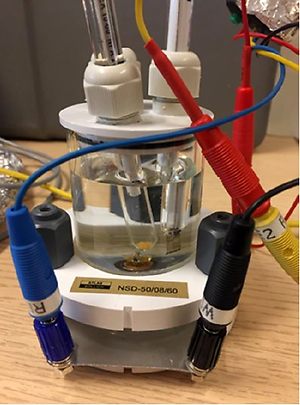Current issue
Online first
Archive
About the Journal
Aims and scope
Publisher and Editorial
Advertising policy
For Authors
Paper review procedures
Procedures protecting authentic authorship of papers
Paper preparation manual
Plagiarism check
Publication ethics
Reviewers
APC
Editorial and Scientific Board
Contact
Reviewers
Evaluation of materials used for coatings of electrical connectors used in the electrical harness of passengers cars
1
Faculty of Mechanical Engineering, Division of Automotive Enigneering, Wroclaw University of Science and Technology, Poland
2
Faculty of Mechanical Engineering, Department of Mechanics, Materials and Biomedical Engineering, Wroclaw University of Science and Technology, Poland
Submission date: 2022-01-03
Final revision date: 2022-05-25
Acceptance date: 2022-05-29
Online publication date: 2022-07-07
Publication date: 2023-01-02
Corresponding author
Paulina Adamczyk
Faculty of Mechanical Engineering, Division of Automotive Enigneering, Wroclaw University of Science and Technology, Wrocław, Poland
Faculty of Mechanical Engineering, Division of Automotive Enigneering, Wroclaw University of Science and Technology, Wrocław, Poland
Combustion Engines 2023,192(1), 43-49
KEYWORDS
TOPICS
ABSTRACT
Automotive electrical connectors are the essential components of a wiring harness. They are typically made of copper, which has excellent electrical conductivity. Due to the limited corrosion resistance of pure copper, connectors are often coated with other metals. In this paper, the qualities of coatings made of gold and tin are investigated and compared. The samples were examined by a metallographic microscope and scanning electron microscope (SEM). The examination revealed uneven thickness, delamination of the coatings, and issues with the preparation of the core material for coating. Numerous burrs and irregularities were observed. Selected samples were examined in salt solution to test their corrosion resistance. Even though gold is a noble metal and its electrochemical potential is higher, the tin coating was more resistant to corrosion.
REFERENCES (18)
1.
Tilindis J, Kleiza V. The effect of learning factors due to low volume order fluctuations in the automotive wiring harness production. Procedia CIRP. 2014;19(C):129-134. https://doi.org/10.1016/j.proc....
2.
Kloch K, Kozak P, Mlyniec A. A review and perspectives on predicting the performance and durability of electrical contacts in automotive applications. Eng Fail Anal. 2021;(121):105143. https://doi.org/10.1016/j.engf....
3.
Swingler J, McBride J, Maul C. Degradation of road tested automotive connectors. IEEE Transactions on Components and Packaging Technologies. 2000;23(1):157-164. https://doi.org/10.1109/6144.8....
4.
LAM, Y., MAUL, C., MCBRIDE, J.W. Temperature, humidity and pressure measurement on automotive connectors. IEEE T Compon Pack T. 2006;29(2): 333-340. https://doi.org/10.1109/TCAPT.....
5.
Łoza Ł. The analysis of vibrations in the vehicle with naturally aspirated and turbocharged gasoline engine. Combustion Engines. 2020;181(2):19-23. https://doi.org/10.19206/CE-20....
6.
Abdi R, Benjemâa N. The effect of the temperature on the wear and resistance of automotive connectors subjected to vibration tests. P I Mech Eng D-J Aut. 2015;229(2):189-196. https://doi.org/10.1177/095440....
7.
Osipowicz T, Lisowski M. The influence of corrosion phenomena on operational parameters of modern fuel injectors CI-engines. Combustion Engines. 2017;171(4):17-23. https://doi.org/10.19206/CE-20....
8.
Merkisz-Guranowska A. Product recycling of automotive parts – trends and issues. Combustion Engines. 2017; 171(4):24-28. https://doi.org/10.19206/CE-20....
10.
Bahadori A. Principle of electrochemical corrosion and cathodic protection. Cathodic corrosion protection systems. Gulf Professional Publishing. 2014:1-34. https://doi.org/10.1016/B978-0....
11.
Braunovic M, Konchits V, Myshkin N. Electrical Contacts: Fundamentals, Applications and Technology. CRC Press. Boca Raton 2006.
12.
Meyyappan K, Murtagian G, Kurella A, Pathangey B, McAllister A, Parupalii S. Corrosion studies on gold-plated electrical contacts. IEEE T Device Mat Re. 2014;14(3):869-877. https://doi.org/10.1109/TDMR.2....
13.
Monlevade E, Cardoso I, Maciel E, Alonso-Falleiros N. Galvanic corrosion of electroless nickel/immersion gold plated non-permanent electric contacts used in electronic devices–direct evidence of triggering mechanism. Eng Fail Anal. 2019; (96):562-569. https://doi.org/10.1016/J.ENGF....
14.
Yuan H, Song J, Schinow V. Fretting corrosion of tin coated electrical contacts: The influence of normal force, coating thickness and geometry of sample configuration. IEEE 62nd Holm Conference on Electrical Contacts (Holm). 2016:33-38. https://doi.org/10.1109/HOLM.2....
15.
Ren W, Zhang C, Du Q, Du D, Wang H. Experimental investigation of cold adhesion failure physical mechanism of gold plated contact within the Micro-Electro-mechanical-Relay. Eng Fail Anal. 2021;(121):105-151. https://doi.org/10.1016/J.ENGF....
16.
Narayanan S, Park Y, Lee K. Fretting corrosion of lubricated tin plated copper alloy contacts: Effect of temperature. Tribol Int. 2008;41(2):87-102. https://doi.org/10.1016/J.TRIB....
17.
Zhang X, Qian Q, Qiang L, Zhang B, Zhang J. Comparison study of gold coatings prepared by traditional and modified galvanic replacement deposition for corrosion prevention of copper. Microelectron Reliab. 2020;(110):113695. https://doi.org/10.1016/J.MICR....
18.
Arazna A, Krolikowski A, Koziol G, Bielinski J. The corrosion characteristics and solderability of immersion tin coatings on copper. Mater Corros. 2012;64(10):914-925. https://doi.org/10.1002/maco.2....
We process personal data collected when visiting the website. The function of obtaining information about users and their behavior is carried out by voluntarily entered information in forms and saving cookies in end devices. Data, including cookies, are used to provide services, improve the user experience and to analyze the traffic in accordance with the Privacy policy. Data are also collected and processed by Google Analytics tool (more).
You can change cookies settings in your browser. Restricted use of cookies in the browser configuration may affect some functionalities of the website.
You can change cookies settings in your browser. Restricted use of cookies in the browser configuration may affect some functionalities of the website.



